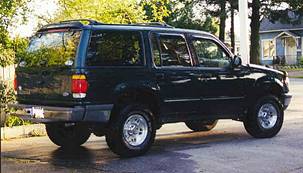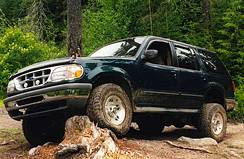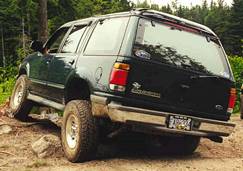Here is the procedure for giving your late model
the inches you desire, while we wait for the aftermarket companies to
design and market a true suspension lift. It can be accomplished
by anyone who is mildly mechanically inclined and only requires the following
tools:

1 can Liquid Wrench (or any penetrating oil)
1 Jack and Jackstands
1 Socket Wrench
1 Measuring Tape
1. With the truck level, measure the distance
from the center of the wheelwell lip to the top center of your wheel on
each side. Mark the distance for each side, it will be important
for two reasons. First you want to ensure that both sides are level
when you're done, and second you want to limit the lift to no more than
2" from stock. (Any higher will cause stress to your CV joints, resulting
in accelerated wear and possibly failure)

2. Now jack up the front end and secure on
jackstands to take the pressure off the torsion bars. Slide underneath
and find the two adjuster bolts located near the back of both torsion bars
(towards the rear of the truck) and spray liberally with some Liquid Wrench.
Let it soak in for 10 mins. to free up the bolts. Using the socket
wrench, tighten up the bolts until they are almost to the end of their
travel. This will torque up the torsion bars, causing them to lift
the front end higher. Now lower the front end and take the same measurements
as you did before you began, to determine the lift gained. Repeat
the tightening/loosening of the bolts until both sides are level and lift
gained is no more than 2".

3. Take the truck out for a 10 minute drive.
This will cause the torsion bars to "settle" and will most likely give
you 1.5-1.75" of final lift, which is ideally where you want to be.
The rear can be lifted using either extended shackles (limited lift) or
by adding an add-a-leaf (full length recommended). After the rear
is lifted and you're content with the new height, be sure to take your
vehicle to get an alignment, as you may have altered it after the torsion
bar lift. The combination of torsion bar lift and add-a-leaf does
firm up the ride, but in my opinion improves it and in no way degrades
it. The Explorer is already a soft riding suspension, and after the
lift body roll and nose dive is almost entirely eliminated. So much
so that I will be removing the rear swaybar in order to improve articulation
(wheel travel).
Itís readily accepted that the late model Explorers will fit 31x10.5/15
tires at stock height, as my í96 did. I only experienced slight rubbing
in the rear, and only during full compression while off-roading.
After the 2Ē lift front and 2.5Ē lift in the rear I have yet to experience
any rubbing at all, even when putting the suspension to itís limits.
Iím confidant that 32s could be easily fit after the lift, but Iím looking
at a set of 33x10.5/15 tires to replace my 31s, once they are worn down,
which will give me the height I desire, without the worry of rubbing from
having too wide a tire.
Good luck.
Andrew Brlic
EXPLORER HOME | MORE
EXPLORERS
|



